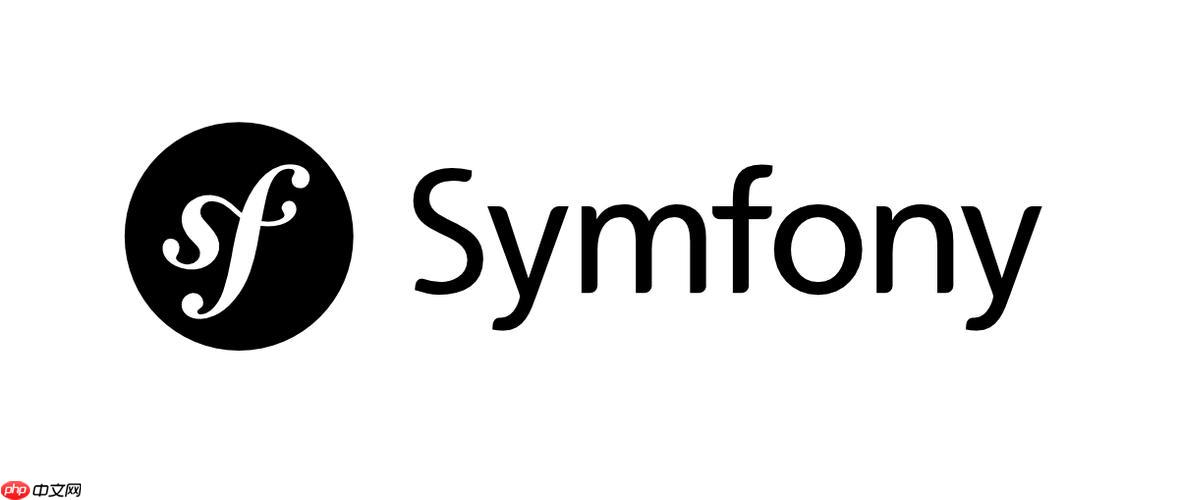获取所有已注册bundle的详细信息并转为数组:通过kernelinterface的getbundles()方法获取bundle实例,结合reflectionclass获取名称、命名空间、路径等属性,组织成结构化数组;2. 提取特定bundle的配置为数组:利用containerbaginterface访问容器中的参数,根据配置键名逐个提取并组合成数组,或在自定义bundle的extension中解析完整配置树;3. 其他可转换为数组的组件信息包括:通过routerinterface获取所有路由信息(如路径、方法、默认值等)组成数组;在compilerpass中通过containerbuilder提取服务定义信息(如类名、标签、公共性等)并存为参数供运行时使用;通过doctrine的entitymanagerinterface获取所有实体的元数据(如字段、关联、表名等)并结构化为数组,以便程序处理。

在Symfony中,并没有一个叫做“模块”的直接概念,但我们通常指的是Bundle、服务、路由、配置等构成应用逻辑的各个部分。要将这些信息转化为数组,核心在于利用Symfony的各种组件(如内核、容器、路由收集器)提供的API,以编程方式提取并结构化这些数据。这通常是为了自动化某些任务,比如生成文档、进行代码分析,或是动态调整应用行为。
要将Symfony中的组件信息转换为数组,主要有以下几种途径:
Kernel
ContainerBagInterface
ParameterBagInterface
config/packages/*.yaml
debug:container
ContainerBuilder
RouterInterface
获取Symfony应用中所有已注册Bundle的详细信息,并将其组织成一个结构化的数组,这在很多场景下都非常有用,比如你需要动态地了解哪些功能模块被激活,或者要根据Bundle的存在与否来调整某些行为。
我们知道,Symfony的
Kernel
Kernel
Kernel
getBundles()
BundleInterface
一个常见的做法是遍历这些Bundle实例,然后对每个实例使用
ReflectionClass
<?php
namespace App\Service;
use Symfony\Component\HttpKernel\KernelInterface;
use ReflectionClass;
class BundleInfoCollector
{
private KernelInterface $kernel;
public function __construct(KernelInterface $kernel)
{
$this->kernel = $kernel;
}
public function getAllBundlesAsArray(): array
{
$bundleInfo = [];
foreach ($this->kernel->getBundles() as $bundle) {
$reflection = new ReflectionClass($bundle);
$bundleInfo[] = [
'name' => $bundle->getName(),
'namespace' => $reflection->getNamespaceName(),
'path' => $reflection->getFileName() ? dirname($reflection->getFileName()) : null,
'className' => $reflection->getName(),
'isBooted' => $bundle->isBooted(), // 是否已启动
// 还可以添加其他你感兴趣的信息,比如:
// 'parent' => $bundle->getParent(), // 如果是子Bundle
];
}
return $bundleInfo;
}
}在实际应用中,你可能需要将这个服务注入到某个控制器或命令中去使用。比如在一个CLI命令里,你可以这样获取并打印:
// In a Symfony Command
use Symfony\Component\Console\Command\Command;
use Symfony\Component\Console\Input\InputInterface;
use Symfony\Component\Console\Output\OutputInterface;
use App\Service\BundleInfoCollector; // 假设你的服务在这个命名空间
class ListBundlesCommand extends Command
{
protected static $defaultName = 'app:list-bundles';
private BundleInfoCollector $bundleInfoCollector;
public function __construct(BundleInfoCollector $bundleInfoCollector)
{
parent::__construct();
$this->bundleInfoCollector = $bundleInfoCollector;
}
protected function execute(InputInterface $input, OutputInterface $output): int
{
$bundles = $this->bundleInfoCollector->getAllBundlesAsArray();
$output->writeln(json_encode($bundles, JSON_PRETTY_PRINT | JSON_UNESCAPED_UNICODE));
return Command::SUCCESS;
}
}这样,你就能得到一个包含所有Bundle名称、命名空间、路径等详细信息的数组,方便后续的处理或展示。需要注意的是,
getFileName()
false
在Symfony中,Bundle的配置通常定义在
config/packages/
最常见且推荐的方式是通过
ContainerBagInterface
ParameterBagInterface
my_bundle_name:
假设你的
config/packages/my_bundle.yaml
# config/packages/my_bundle.yaml
my_bundle:
enabled: true
api_key: 'some_secret_key'
features:
- 'feature_a'
- 'feature_b'
settings:
max_items: 100
timeout: 30你不能直接通过
ContainerBagInterface
my_bundle
Configuration
如果你想获取的是这些配置的最终合并结果,最直接的方法是:
MyBundleConfigService
ContainerBagInterface
ParameterBagInterface
Extension
MyBundleExtension.php
Configuration
load()
这里我们假设你希望在运行时获取某个Bundle的“配置信息”,这通常意味着它已经被注入到某个服务中,或者你定义了特定的参数。
<?php
namespace App\Service;
use Symfony\Component\DependencyInjection\ParameterBag\ContainerBagInterface;
class BundleConfigReader
{
private ContainerBagInterface $params;
public function __construct(ContainerBagInterface $params)
{
$this->params = $params;
}
/**
* 尝试获取一个特定Bundle的配置。
* 注意:这取决于Bundle如何将其配置注册到容器中。
* 很多Bundle不会直接将整个配置树作为顶级参数。
*/
public function getMyBundleConfig(): ?array
{
// 假设 'my_bundle.enabled' 是一个参数
$enabled = $this->params->has('my_bundle.enabled') ? $this->params->get('my_bundle.enabled') : null;
// 假设 'my_bundle.api_key' 是一个参数
$apiKey = $this->params->has('my_bundle.api_key') ? $this->params->get('my_bundle.api_key') : null;
// 对于复杂的结构,如 'my_bundle.features' 或 'my_bundle.settings',
// 它们可能被注册为完整的数组参数,或者需要逐级访问。
$features = $this->params->has('my_bundle.features') ? $this->params->get('my_bundle.features') : [];
$settings = $this->params->has('my_bundle.settings') ? $this->params->get('my_bundle.settings') : [];
if ($enabled === null && $apiKey === null && empty($features) && empty($settings)) {
return null; // 没有找到任何相关配置
}
return [
'enabled' => $enabled,
'api_key' => $apiKey,
'features' => $features,
'settings' => $settings,
];
}
/**
* 如果你知道某个顶级参数包含了整个配置树,可以直接获取。
* 例如,如果你在 services.yaml 中定义了一个参数:
* parameters:
* app.my_custom_config:
* key1: value1
* key2: value2
*/
public function getCustomGlobalConfig(string $paramName): ?array
{
if ($this->params->has($paramName)) {
$config = $this->params->get($paramName);
if (is_array($config)) {
return $config;
}
}
return null;
}
}在实际操作中,如果你需要获取的是任何Bundle的配置,并且它没有被显式地注册为参数,那么你可能需要更深入地了解Symfony的编译过程,或者编写一个
CompilerPass
ContainerBuilder
ContainerBagInterface
除了Bundle和配置,Symfony还有许多其他重要的组件信息,它们同样可以被提取并转换为数组,用于自动化任务、调试、分析或动态调整应用程序行为。
路由信息(Routes) 路由是Symfony应用中非常核心的一部分,它定义了URL如何映射到控制器动作。获取所有路由信息并将其转换为数组,可以用于生成API文档、构建动态菜单、或者进行路由分析。 Symfony的
RouterInterface
<?php
namespace App\Service;
use Symfony\Component\Routing\RouterInterface;
class RouteInfoCollector
{
private RouterInterface $router;
public function __construct(RouterInterface $router)
{
$this->router = $router;
}
public function getAllRoutesAsArray(): array
{
$routesInfo = [];
$routeCollection = $this->router->getRouteCollection();
foreach ($routeCollection->all() as $name => $route) {
$routesInfo[] = [
'name' => $name,
'path' => $route->getPath(),
'host' => $route->getHost(),
'methods' => $route->getMethods(),
'defaults' => $route->getDefaults(),
'requirements' => $route->getRequirements(),
'options' => $route->getOptions(),
// 'schemes' => $route->getSchemes(), // 某些Symfony版本可能不支持直接获取
];
}
return $routesInfo;
}
}这个服务可以让你得到一个包含所有路由名称、路径、HTTP方法、默认值、需求等信息的数组。
服务定义信息(Service Definitions) 获取所有服务定义并转换为数组是一个更高级且更复杂的需求,通常在编译阶段(
CompilerPass
bin/console debug:container --json
CompilerPass
ContainerBuilder
// In a CompilerPass (e.g., App/DependencyInjection/Compiler/ServiceDefinitionCollectorPass.php)
namespace App\DependencyInjection\Compiler;
use Symfony\Component\DependencyInjection\Compiler\CompilerPassInterface;
use Symfony\Component\DependencyInjection\ContainerBuilder;
use Symfony\Component\DependencyInjection\Definition;
class ServiceDefinitionCollectorPass implements CompilerPassInterface
{
public function process(ContainerBuilder $container): void
{
$serviceDefinitions = [];
foreach ($container->getDefinitions() as $id => $definition) {
// 排除抽象服务定义
if ($definition->isAbstract()) {
continue;
}
$serviceDefinitions[$id] = [
'class' => $definition->getClass(),
'public' => $definition->isPublic(),
'synthetic' => $definition->isSynthetic(),
'lazy' => $definition->isLazy(),
'tags' => $definition->getTags(),
// 还可以获取其他信息,如构造函数参数、方法调用等,但会更复杂
// 'arguments' => $definition->getArguments(),
];
}
// 将这些定义作为参数存储起来,以便运行时访问
$container->setParameter('app.service_definitions', $serviceDefinitions);
}
}然后你需要在
AppKernel.php
CompilerPass
ContainerBagInterface
app.service_definitions
Doctrine实体元数据(Entity Metadata) 如果你在使用Doctrine ORM,你可能需要获取所有实体类的信息,比如它们的字段、关联关系、表名等。这对于数据库迁移工具、API文档生成或ORM层面的动态操作非常有用。
EntityManagerInterface
<?php
namespace App\Service;
use Doctrine\ORM\EntityManagerInterface;
use Doctrine\ORM\Mapping\ClassMetadata;
class EntityInfoCollector
{
private EntityManagerInterface $em;
public function __construct(EntityManagerInterface $em)
{
$this->em = $em;
}
public function getAllEntitiesAsArray(): array
{
$entityInfo = [];
$metadatas = $this->em->getMetadataFactory()->getAllMetadata();
foreach ($metadatas as $metadata) {
/* @var ClassMetadata $metadata */
$fields = [];
foreach ($metadata->getFieldNames() as $fieldName) {
$fields[$fieldName] = $metadata->getFieldMapping($fieldName);
}
$associations = [];
foreach ($metadata->getAssociationNames() as $associationName) {
$associations[$associationName] = $metadata->getAssociationMapping($associationName);
}
$entityInfo[] = [
'className' => $metadata->getName(),
'tableName' => $metadata->getTableName(),
'identifier' => $metadata->getIdentifier(), // 主键字段
'fields' => $fields,
'associations' => $associations,
'isMappedSuperclass' => $metadata->isMappedSuperclass,
'isEmbeddedClass' => $metadata->isEmbeddedClass,
'isInheritanceRoot' => $metadata->isInheritanceRoot,
];
}
return $entityInfo;
}
}这个服务将返回一个数组,其中包含了每个实体类的名称、对应的数据库表名、主键、所有字段及其映射信息,以及关联关系等。
这些例子展示了Symfony的强大之处,它通过提供丰富的API,让开发者能够以编程方式深入了解和操作应用程序的各个方面,从而实现高度定制化和自动化。
以上就是Symfony 如何将模块信息转为数组的详细内容,更多请关注php中文网其它相关文章!

每个人都需要一台速度更快、更稳定的 PC。随着时间的推移,垃圾文件、旧注册表数据和不必要的后台进程会占用资源并降低性能。幸运的是,许多工具可以让 Windows 保持平稳运行。

Copyright 2014-2025 //m.sbmmt.com/ All Rights Reserved | php.cn | 湘ICP备2023035733号